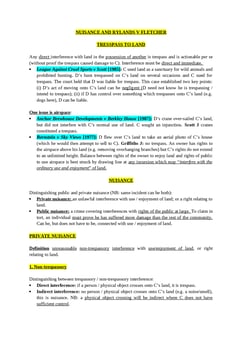- Law Cases
- Tort Law Cases
- Defective Premises; Negligence: Duty and Standard of Care; Cost of Prevention Cases
Tomlinson v Congleton BC (Borough Council) [2004] UKHL 47; [2001] 1 AC 46; [2003] 3 WLR 705
Judgement for the case Tomlinson v Congleton BC (Borough Council)
Table Of Contents
KEY POINTS
There is no distinction between an unauthorised trespasser and an individual who, despite having permission to enter the premises, engages in an activity for which they have not been granted permission.
Determining what constitutes "reasonable care in all the circumstances" depends on considering various factors, similar to how negligence is assessed in common law.
An occupier's duty to ensure the safety of visitors is not absolute and must be balanced against the burden and expense of taking preventive measures.
FACTS
John Tomlinson visited Brereton Heath Country Park which has a 14-acre lake that had sandy beaches where people would gather for recreational activities. The lake and entrance to the park contain the sign, “Dangerous Water. No Swimming.”
Tomlinson decided to cool off by diving into the lake. Unfortunately, the dive went wrong, and he suffered a severe neck injury, breaking his fifth vertebra and resulting in tetraplegia, leaving him unable to walk.
Tomlinson took legal action against both Congleton Borough Council and Cheshire County Council, claiming that as the occupiers of the park, they had breached their responsibilities under the Occupiers' Liability Acts of 1957 and 1984.
COMMENTARY
The case highlighted the standard duty of care owed by the occupier.
The Court clarified that the duty of care is not an absolute obligation to eliminate all risks. Instead, the occupier is required to take reasonable steps to ensure the safety of visitors, considering factors such as the likelihood of injury, severity of potential harm, and the social value of the activity.
In this case, the Court found that the dangers associated with diving into the lake were obvious and would have been apparent to a reasonable person. As a result, the Council did not breach its duty of care by failing to warn against or prevent such obvious risks.
ORIGINAL ANALYSIS
A lake had formed in a park run by Defendant and was dangerous. Defendant put up signs warning people not to swim and employed people to walk around the park and warn people not to swim. It knew that sometimes people disobeyed the warnings but could not afford to take additional measures.
Plaintiff decided to dive in at a shallow part and was injured.
HL dismissed his claim against Defendant, saying that the injury was not caused by the state of the premises but by Plaintiff’s act in diving in the shallow end (judge had found that the lake was no more dangerous than any stretch of water).
Also HL held that this was not a risk against which Defendant might be reasonably be expected to offer some protection within s.1(3)(c) (for same reasons as in Bolton v Stone). Therefore no duty arose in connection with diving in the shallow end.
Lord Hoffmann
There is debate about whether Plaintiff could come within either category of visitor or NV: Obviously Plaintiff was not a visitor since swimming in the lake was prohibited.
However, before entering the lake he was not a trespasser and therefore the 1984 Act did not apply to him, while his injury was pretty much instantaneous (Plaintiff did not paddle around before being injured). Therefore could he really have become a NV in the moment between touching the water and sustaining an injury?
Hoffmann’s solution is purposive reasoning: the 1984 Act was intended to apply to those who wrongfully entered property or used it for a purpose for which they were not invited. In reality this is the sort of situation which was intended to come within the 1984 Act.
The danger was caused by an activity with “inherent risk” (diving in shallow water) and NOT due to any special dangers associated with the lake. No duty is owed by O to a NV who undertakes an inherently risky activity not caused by the state of the premises or acts or omissions done to it. Also, because the activity was obviously dangerous, it was NOT within s.1(3)(c) i.e. one against which Defendant should offer protection.
In obiter, he says that assessing what is a reasonable protective measure to offer “in all the circumstances”, cost of the measures and the social value of the activity should be taken into account.
The key difference between the 1957 Act and the 1984 Act is that in the former one starts from the assumption that there is a duty, while in the latter one assumes there is not.
RELATED CASES
For Further Study on Tomlinson v Congleton BC (Borough Council)
Need instant answers? Our AI exam tutor is here to help.
Ask questions 🙋 Get answers 📔 It's simple 👁️👄👁️
Our AI is educated by the highest scoring students across all subjects and schools. Join hundreds of your peers today.
Get StartedSimilar Cases
Related Product Samples
These product samples contain the same concepts we cover in this case.
| Tort Law | Occupier's Liability Notes (27 pages) |

 Since 2010, Oxbridge Notes has been a trusted education marketplace, supplying high-quality materials from top achievers at universities like Oxford, Cambridge, LSE, Harvard, and Yale.
Since 2010, Oxbridge Notes has been a trusted education marketplace, supplying high-quality materials from top achievers at universities like Oxford, Cambridge, LSE, Harvard, and Yale.